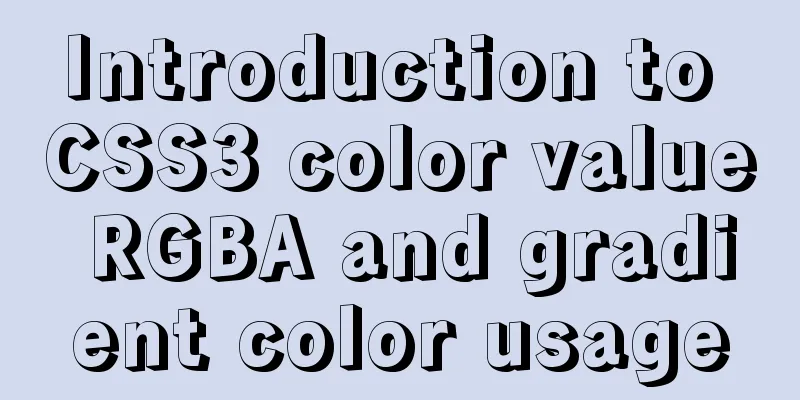Introduction to CSS3 color value RGBA and gradient color usage

|
Before CSS3, gradient images could only be used as background images Color value RGBA The RGB color standard we are familiar with is composed of three colors: r (red), g (green), and b (blue) to form various colors with values of 0~255, or 0~100%. RGBA adds an alpha opacity parameter to RGB. Example 1: Normal red RGB color
.demo {
width: 100px;
height: 100px;
background-color: rgb(255, 0, 0);
}
Example 2: Using RGBA to create a red translucent effect
.demo {
width: 100px;
height: 100px;
background-color: rgba(255, 0, 0, 0.5);
}
Linear-gradient Gradient means "inclination", linear means "linear". Gradient color is a smooth transition between multiple colors to form a gorgeous color. The linear-gradient parameters include the direction of the gradient (optional) and any number of gradient colors. Example 3: Red, green and blue gradient colors
.demo {
width: 100px;
height: 100px;
background: linear-gradient(red,lime,blue);
} Note that I wrote background here, not background-color
If the gradient direction is not filled in, it defaults to being from top to bottom. The gradient direction has the following property values
.demo {
width: 100px;
height: 100px;
background: linear-gradient(to top left,red,lime,blue);
}
Angle 0deg is equivalent to to top, increasing the angle is equivalent to rotating clockwise
.demo {
width: 100px;
height: 100px;
background: linear-gradient(20deg,red,lime,blue);
}
You can add the position of each color gradient after each color
.demo {
width: 100px;
height: 100px;
background: linear-gradient(red 30%,lime 50%,blue 70%);
}
If you don't fill it in, the browser will divide it equally by default. For example, the three color values are 0%, 50%, and 100% by default. There is also an unusual function repeating-linear-gradient that allows us to repeat the linear gradient
.demo {
width: 100px;
height: 100px;
background: repeating-linear-gradient(red, rgba(100,100,100,0.5),blue 50%);
}
The result is this ugly gradient color. radial-gradient radial means "radial, radiating"
.demo {
width: 200px;
height: 100px;
background: radial-gradient(red,lime,blue);
}
Similar to linear gradient, but the first parameter (optional) is the gradient shape of radial gradient. The position can be circle or ellipse (default).
.demo {
width: 200px;
height: 100px;
background: radial-gradient(circle,red,lime,blue);
}
You can use the shape at position format to define the position of the gradient center.
.demo {
width: 200px;
height: 100px;
background: radial-gradient(circle at 30% 30%,red,lime,blue);
}
The gradient position can be expressed in percentage or pixel form. If only one value is entered, the other value defaults to the middle position 50%.
.demo {
width: 200px;
height: 100px;
background: radial-gradient(circle at 30%,red,lime,blue);
}
If you don't want to use keywords, you can also use numbers for gradient sizes.
.demo {
width: 200px;
height: 100px;
background: radial-gradient(100px 100px at 50px 50px,red,lime,blue);
}Indicates gradient size 100px*100px, gradient position 50px*50px
Radial gradient also has a repeated gradient function, which is similar to linear gradient. I won't explain it here.
.demo {
width: 200px;
height: 100px;
background: repeating-radial-gradient(red 10%,lime 20%,blue 30%);
}
This is the end of this article about the use of CSS3 color value RGBA and gradient colors. For more relevant CSS3 RGBA and gradient color content, please search 123WORDPRESS.COM’s previous articles or continue to browse the following related articles. I hope everyone will support 123WORDPRESS.COM in the future! |
<<: WeChat applet uniapp realizes the left swipe to delete effect (complete code)
>>: Steps of an excellent registration process
Recommend
Vue3+Vite+TS implements secondary encapsulation of element-plus business components sfasga
Table of contents 1. Structure string 2. Return t...
How to use mqtt in uniapp project
Table of contents 1. Reference plugins in the uni...
js simple and crude publish and subscribe sample code
What is Publish/Subscribe? Let me give you an exa...
Design sharing of the download page of the Pengyou.com mobile client (picture and text)
Let's first look at some simple data: Accordin...
Use Nginx to build a streaming media server to realize live broadcast function
Written in front In recent years, the live stream...
Lambda expression principles and examples
Lambda Expressions Lambda expressions, also known...
The difference and introduction of ARGB, RGB and RGBA
ARGB is a color mode, which is the RGB color mode...
Nodejs error handling process record
This article takes the connection error ECONNREFU...
HTML tutorial, easy to learn HTML language (2)
*******************Introduction to HTML language (...
Detailed explanation of configuring Docker's yum source and installing it in CentOS7
CentOS7 is used here, and the kernel version is [...
Vue echarts realizes horizontal bar chart
This article shares the specific code of vue echa...
About React Native unable to link to the simulator
React Native can develop iOS and Android native a...
Design perspective technology is an important capital of design ability
A design soldier asked: "Can I just do pure ...
Example code of how CSS matches multiple classes
CSS matches multiple classes The following HTML t...
Tomcat uses thread pool to handle remote concurrent requests
By understanding how tomcat handles concurrent re...























